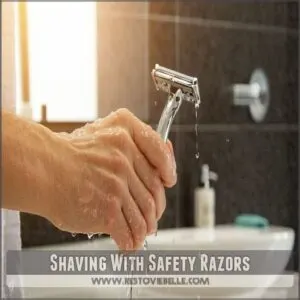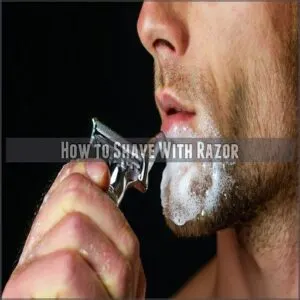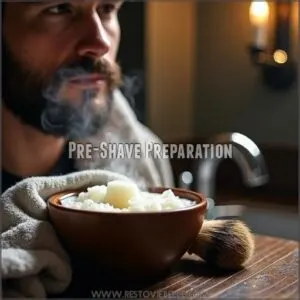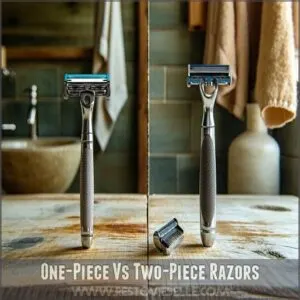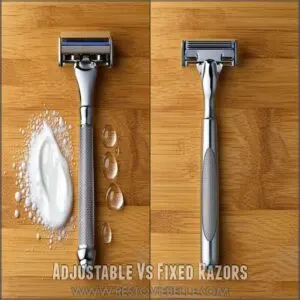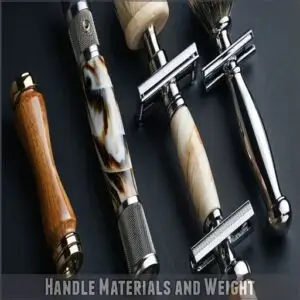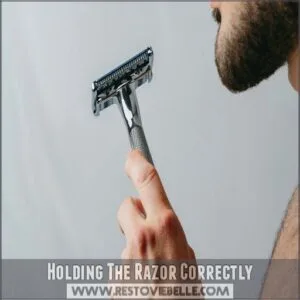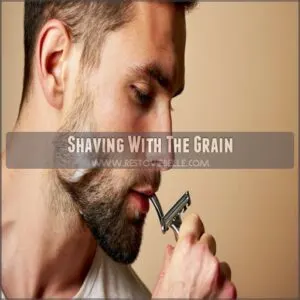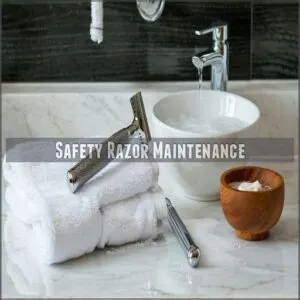This site is supported by our readers. We may earn a commission, at no cost to you, if you purchase through links.
 Ready to master how to shave with a safety razor? Start by softening your beard with warm water and creating a rich lather using quality shaving cream.
Ready to master how to shave with a safety razor? Start by softening your beard with warm water and creating a rich lather using quality shaving cream.
Load a fresh blade into your razor, holding it at a precise 30-degree angle against your skin. Shave with the grain using gentle, short strokes and let the razor’s weight do the work—no need for extra pressure.
Rinse the blade frequently to prevent clogging and irritation. After your shave, apply a soothing, alcohol-free balm to calm your skin.
With practice, you’ll transform your shaving routine from a chore to an art form, saying goodbye to expensive cartridge razors forever.
Table Of Contents
- Key Takeaways
- Shaving With Safety Razors
- How to Shave With Razor
- Pre-Shave Preparation
- Choosing Right Safety Razor
- Shaving Techniques Explained
- Safety Razor Maintenance
- Common Shaving Mistakes
- Post-Shave Skincare Routine
- Mastering Safety Razor Skills
- Safety Razor Benefits Explained
- Frequently Asked Questions (FAQs)
- Is shaving with a safety razor better?
- Do you shave up or down with safety razor?
- How do you not cut yourself when shaving with a safety razor?
- How do you shave with a safety razor?
- Can You shave with a safety razor?
- How to get a close shave with a safety razor?
- How to use a safety razor?
- How do you care for a safety razor after shaving?
- How to get the best shave with a safety razor?
- How do you use a safety razor for beginners?
- Conclusion
Key Takeaways
- Prep your skin with warm water, a rich lather, and optionally pre-shave oil to soften hair and ensure a smoother shave.
- Hold the razor at a 30-degree angle and let its weight do the work; use light, short strokes with the grain to avoid irritation.
- Rinse the blade frequently to prevent clogging, and re-lather for a second pass if needed for a closer shave.
- Finish with a soothing balm to calm your skin and lock in hydration.
Shaving With Safety Razors
Are you tired of spending a fortune on cartridge razors that leave your skin irritated and your wallet empty?
Say hello to the safety razor—your ticket to a closer, smoother shave that’ll save you serious cash in the long run.
Benefits of Safety Razors
Switching to a safety razor isn’t just nostalgic—it’s smarter.
Enjoy a closer shave with less irritation, epic for sensitive skin or coarse hair. Plus, it’s kinder to your wallet and the planet.
Here’s why:
- Skin Benefits: Fewer blades mean less irritation.
- Razor Efficiency: Tackle hair effortlessly.
- Shaving Comfort: Smooth shaving control every time.
History of Safety Razors
King Camp Gillette changed razor shaving forever in 1901 with his innovative safety razor.
Unlike the dangerous straight razors of the past, his design focused on user safety and ease.
Thanks to this game-changing invention, classic designs like vintage razors remain timeless.
Razor evolution brought shaving innovations, making safety razor shaving a reliable and precise choice still loved today.
Types of Safety Razors
Safety razors come in various types suited for personalized shaving.
Here’s a quick breakdown:
- One-Piece Razors: Easy butterfly openings for blade swaps.
- Two-Piece Razors: Balanced design for smooth handling.
- Three-Piece Razors: Great for cleaning and durability.
- Adjustable Razors: Control blade exposure for a customized shave.
Explore handle designs, razor materials, and blade types to find your perfect fit!
How to Shave With Razor
Wondering how to nail safety razor shaving like a pro? Here’s how: start by mastering the razor grip—hold it lightly, like you’re cradling a fragile glass. Keep the razor angle at 30-40 degrees; let the blade do work pressing hard. Blade sharpness matters, so don’t skimp on swapping old blades for fresh Safety Razor Blades.
Follow these steps for a smooth shave:
- Map the hair growth for your skin first.
- Use short, deliberate strokes to avoid nicks.
- Rinse the blade often to c.
- Re-lather and go for a second pass, if needed.
- Finish light areas, but stick to proper shaving techniques.
Relax, enjoy the process—you’re in control now!
Pre-Shave Preparation
Getting your skin and hair ready before shaving isn’t just a fancy step—it’s the secret to a smoother, irritation-free shave.
By softening your beard and creating a rich lather, you’ll set the stage for your razor to do its job effortlessly.
Softening Skin and Hair
A proper pre-shave routine starts with softening your skin and hair.
Warm water works wonders—try a hot shower or press a steamy towel onto your face.
For extra help, use a preshave cream suited to your skin type.
These soothing techniques also hydrate and prep your hair texture, making shaving with the grain smoother and irritation-free.
Applying Pre-Shave Oil
A good pre-shave oil is your skin’s secret weapon.
It softens the hair, hydrates dry spots, and creates a smoother razor glide.
Choose an oil that matches your skin type—lighter for oily skin, richer for dry.
This step in your preshave preparation reduces razor drag and irritation, setting you up for success in safety razor shaving.
Don’t skip it!
Creating Lather
After applying pre-shave oil, it’s time to build the perfect lather.
Grab quality shaving soap or cream, a reliable brush, and use warm water—not too hot.
Swirl the brush until a rich foam texture forms.
The right lather creation transforms your shave, letting the blade glide effortlessly.
Choosing great soap and controlling water temperature makes all the difference.
Choosing Right Safety Razor
Picking the right safety can make all the difference between a smooth shave and unnecessary frustration.
From one-piece designs to adjustable options, you’ve got plenty of choices to match your needs and style.
One-Piece Vs Two-Piece Razors
Choosing between one-piece two-piece safety razors isn’t complicated.
One-piece razors, often called “butterfly razors,” open easily for blade changes, offering convenience and solid Razor Balance.
Two-piece designs separate the handle and head, making cleaning a breeze.
Both handle designs guarantee sturdy construction and great Safety Features, but your choice depends on personal preference and how hands-on you like to be.
When selecting a safety razor, consider the safety razors available to find the best fit for your shaving needs and enjoy the benefits of personal preference.
Adjustable Vs Fixed Razors
Adjustable razors let you tweak blade exposure and razor flex for the perfect shave, while fixed razors keep things simple with steady settings.
If you want more control over razor balance, adjustable heads are your friend. To find the best safety razor for your needs, consider factors like skin type and beard thickness.
Fixed razors are great for beginners or anyone who loves consistency, and a razor shaving guide can help find what suits your style.
Handle Materials and Weight
After exploring adjustable razors, let’s zero in on what makes a razor truly yours.
Your safety razor‘s handle is more than just a grip – it’s your shaving wingman.
Metal options like stainless steel, chrome, and ivory resin offer different weight balances and ergonomic designs.
The right handle texture can mean the difference between a smooth glide and a rough ride.
Shaving Techniques Explained
Mastering the art of shaving with a safety razor is about precision, control, and technique that’ll transform your daily grooming routine.
You’ll learn how to hold the razor at the right angle, move with the grain of your hair, and apply just the right amount of pressure to get a smooth, irritation-free shave.
Holding The Razor Correctly
The perfect razor grip can transform your shaving experience from a chore to a smooth ritual.
Master your safety razor handling with these critical techniques:
- Position index finger on razor’s balance point
- Place thumb opposite your index finger
- Support with middle finger for extra control
- Hold razor by handle tip to minimize pressure
- Keep wrist relaxed and aligned with blade angle
To achieve ideal control, consider the safety razor techniques that suit your needs.
Your journey to precision starts here.
Shaving With The Grain
Mastering your razor’s angle is key when shaving with the grain.
Follow your hair’s natural growth direction to minimize irritation and razor burn.
Gentle, short strokes work best, tracking each hair pattern across different areas of your face.
This technique guarantees a smooth, comfortable shave that respects your skin’s unique landscape and prevents painful nicks or cuts.
Applying Gentle Pressure
Razor-wielding warriors know that light pressure is your secret weapon when shaving with a safety razor.
Forget the brute force of cartridge razors – here’s how to master the art of a smooth, irritation-free shave.
- Let the razor’s weight do the heavy lifting
- Glide the blade like you’re painting, not scrubbing
- Keep your touch as soft as a butterfly’s kiss
- Think precision, not pressure
Safety Razor Maintenance
Keeping your safety razor in top shape isn’t just about looking good—it’s about ensuring a smooth, irritation-free shave every time.
You’ll want to master the art of cleaning, storing, and replacing your blade to extend your razor’s life and maintain its cutting edge.
Cleaning The Razor
Two simple steps will revolutionize your razor maintenance game.
Proper cleaning prevents rust and extends your safety razor’s life.
Here’s a quick guide to keep your razor pristine:
| Step | Action | Purpose |
|---|---|---|
| Rinse | Hot water | Remove soap/hair |
| Dry | Soft towel | Prevent moisture |
| Disinfect | Rubbing alcohol | Kill bacteria |
| Oil | Light coating | Rust prevention |
Blade removal and handle cleaning are your new best friends in razor care to achieve proper cleaning.
Storing The Razor
Several razor storage tips can save your prized shaving tool from early retirement. Keep your razor in a dry place away from moisture to prevent rust and extend its life.
Hang it on a stand or tuck it into a cabinet, ensuring it breathes and stays clean. You can find more [safety razor](https://www.badgerandblade.com/forum/threads/how-does-everyone-store-their-safety-razor.
323459/) storage ideas online.
Your razor handles deserve some TLC to maintain peak performance and longevity.
Replacing The Blade
Because blade sharpness matters, swap out your safety razor blade regularly to maintain exceptional performance.
Most experts recommend replacing blades after 5-7 shaves to prevent dullness and skin irritation.
Understanding safety razor maintenance is essential for extending the life of your razor and blades.
Keep your razor handle clean and store replacement blades in a dry, cool spot.
Your skin will thank you for this simple razor maintenance ritual that keeps your shave smooth and precise.
Common Shaving Mistakes
You might think you’re a shaving pro, but common mistakes can turn your smooth routine into a skin-irritating nightmare.
Let’s uncover the top blunders that can wreck your safety razor experience and leave your face feeling like sandpaper.
Applying Too Much Pressure
After keeping your safety razor clean, watch out for a rookie mistake: applying too much pressure. Let the razor’s weight do the heavy lifting.
Pressing hard increases razor burn and skin damage, turning your smooth shave into a painful nightmare.
Keep your touch light and your angle consistent. Your skin will thank you for mastering this razor shaving tip.
Shaving Against The Grain
Recklessly gliding your razor against the grain might seem like a shortcut to smoothness, but it’s a recipe for razor burn and irritation.
When shaving with a safety razor, always prioritize skin health over a closer shave.
Fighting your hair’s natural growth direction creates unnecessary friction, increases cutting depth, and can leave your skin feeling raw and uncomfortable.
Not Rinsing The Razor
A razor clogged with soap scum is a shaving nightmare waiting to happen. Here’s why not rinsing your safety razor is a rookie mistake:
- Soap buildup dulls blade performance
- Mineral deposits create rust hotspots
- Bacteria thrive in uncleaned razor crevices
- Blade edges become gunked with hair and residue
- Water temperature impacts razor maintenance dramatically
Proper alcohol disinfection techniques can greatly improve the cleanliness and longevity of your razor, making it an essential part of your shaving routine.
Clean that razor, or risk a less-than-stellar shave experience.
Post-Shave Skincare Routine
After your close shave with a safety razor, your skin needs some TLC to recover and stay smooth.
Your post-shave skincare routine is essential for reducing irritation, preventing razor burn, and keeping your face feeling fresh and comfortable.
Applying Post-Shave Balm
Got caught dragging your razor against the grain?
Time to soothe that skin with a killer aftershave balm. Your post-shave hero fights razor burn and hydrates like a champ.
Packed with calming ingredients, this magical potion restores your skin’s balance, reducing irritation and leaving you feeling smooth and refreshed.
Your face will thank you later.
Moisturizing The Skin
Your skin’s thirst after shaving demands immediate attention.
Natural moisturizers become your post-shave allies, locking in hydration and soothing razor-stressed skin.
Choose a lightweight, alcohol-free moisturizer that matches your skin type, applying gently in upward motions.
Your daily moisturizing routine isn’t just skincare—it’s a ritual of self-preservation, protecting and nourishing your freshly shaved canvas.
Reducing Irritation
Why do razor burns feel like your skin’s throwing a tantrum? Soothe those sensitive areas by applying a cool, alcohol-free aftershave balm that fights redness and calms irritation.
Understanding shaving causes acne is key to preventing further skin issues. Pat – don’t rub – the product gently.
Tackle razor burn with targeted safety razor tips that minimize skin stress and keep your face feeling smooth and comfortable.
Mastering Safety Razor Skills
Ready to transform your shaving routine and become a safety razor pro?
Learning the art of safety razor shaving isn’t just about technique, it’s about gaining confidence and mastering a skill that’ll save you money and deliver a closer, smoother shave.
Practicing Shaving Techniques
After pampering your skin with post-shave care, it’s time to hone your safety razor skills.
Practice makes perfect with shaving angles and razor grip. Start by mapping your facial terrain, understanding how hair grows.
Experiment with gentle shave strokes, keeping the blade at a steady 30-degree angle. Stretching skin helps create a smooth, controlled glide that’ll have you mastering razor techniques in no time.
Adjusting to New Razor
As you’ve honed your razor skills, getting comfortable with a new safety razor becomes your next mission.
Grip matters more than you think – experiment with handle positions until it feels like an extension of your hand.
Each razor has its own personality, so patience is key during your razor break-in period.
Trust the process, and you’ll master your shave in no time.
Troubleshooting Common Issues
Get started with safety razor troubleshooting like a pro.
When razor clogs, rinse frequently during shaving to prevent buildup. Combat skin irritation by using gentle strokes and a sharp blade.
Watch for ingrown hairs and razor burns, adjusting your technique to minimize these common issues.
Shaving nicks happen – use an alum block to seal and soothe your skin quickly.
Safety Razor Benefits Explained
Say goodbye to razor burn and sky-high cartridge prices with the game-changing safety razor that’ll transform your shaving routine.
You’ll save money and reduce skin irritation, as well as gain precision control that’ll make every shave smoother than ever before.
Closer Shave and Reduced Irritation
After perfecting your technique, you’ll discover safety razors deliver a game-changing shave.
The razor’s single sharp blade glides smoothly, reducing skin irritation across different skin types, by minimizing drag and allowing precise control, these razors cut hair closer without the multi-blade tug-of-war.
Your skin will thank you for ditching those expensive, aggressive cartridge razors.
Environmentally Friendly and Cost-Effective
Beyond smooth skin, your safety razor slashes through wallet-draining cartridge expenses like a budget ninja.
Here’s why going green saves green:
- Razor blades cost pennies compared to multi-blade cartridges
- Zero waste means fewer plastic razors in landfills
- Long-term savings stack up faster than disposable razor prices
Sustainable shaving isn’t just smart – it’s a wallet-friendly revolution that keeps both your face and planet happy.
Increased Control and Precision
While eco-friendly benefits save your wallet, a safety razor puts you in the driver’s seat of your shaving experience.
With razor balance and precise hand movement, you’ll master grip control that cartridge razors can’t match. Understanding Safety Razor techniques is essential for a smooth shave.
Shave angles become your secret weapon, giving you unprecedented blade exposure and a razor-sharp precision that transforms your morning routine into an art form.
Frequently Asked Questions (FAQs)
Is shaving with a safety razor better?
Shaving with a safety razor saves you money and provides a closer, smoother shave.
You’ll control your experience, reduce skin irritation, and enjoy the precision of a single, sharp blade that’s gentler on your skin.
Do you shave up or down with safety razor?
You’d stumble onto a game-changing secret: with a safety razor, start by gliding down with the grain to minimize irritation.
Second pass? Carefully go across or against the grain for that silky-smooth finish you’re craving.
How do you not cut yourself when shaving with a safety razor?
Hold the razor at a 30-40 degree angle, let its weight do the work, and don’t apply pressure.
Pull skin taut, use short strokes with the grain, and rinse the blade frequently to prevent nicks and cuts.
How do you shave with a safety razor?
Between smooth skin and a sharp blade lies the art of safety razor shaving.
Prep your face with warm water, apply shaving soap, and glide the razor at a 30-degree angle, using light strokes with the grain.
Can You shave with a safety razor?
Yes, you can shave with a safety razor! It’s a precise tool that offers a closer, smoother shave.
With practice, you’ll master the technique, save money on blades, and enjoy a more controlled, personalized grooming experience.
How to get a close shave with a safety razor?
Master your close shave by pulling skin taut, keeping a 30-degree angle, and using minimal pressure.
Glide the razor with the grain in short strokes, rinsing frequently.
Repeat with a fresh lather for silky-smooth results.
How to use a safety razor?
Like a skilled surgeon wielding a precise instrument, you’ll glide a safety razor at a 30-degree angle.
Prep your skin, use short strokes, go with the grain, and rinse between passes for a smooth, close shave.
How do you care for a safety razor after shaving?
Rinse your razor under hot water, then towel dry and air it out in a low-humidity spot.
Apply a light oil to prevent rust, and store it in a dry cabinet to maintain its quality and longevity.
How to get the best shave with a safety razor?
With 90% of men reporting skin irritation from multi-blade razors, you’ll want to master the safety razor’s art.
Glide gently, use short strokes, prep your skin, and let the razor’s weight do the work for a smooth, irritation-free shave.
How do you use a safety razor for beginners?
Hold the razor at a 30-degree angle, let its weight do the work, and shave with the grain.
Use short, steady strokes, rinse often, and don’t press down.
Prep well, finish smarter!
Conclusion
Tired of overpaying for mediocre shaves? Switching to a safety razor changes everything.
It’s cost-effective, eco-friendly, and delivers a smooth, precise shave every time.
By mastering how to shave with a safety razor, you’ll ditch irritation, avoid razor burn, and upgrade your routine to something you actually enjoy.
Practice makes perfect, so embrace the learning curve and enjoy the process. With the right prep, technique, and care, you’ll never look back at cartridge razors again.
- https://www.gq.com/story/how-to-safety-razor
- https://grownmanshave.com/blogs/grown-man-shave-society-articles/the-beginners-guide-to-shaving-with-a-double-edge-safety-razor
- https://bespokeunit.com/shaving/safety-razor/how/
- https://www.primandprep.com/how-to-hold-a-safety-razor/
- https://www.beardandblade.com.au/blogs/academy/how-to-shave-with-a-safety-razor

